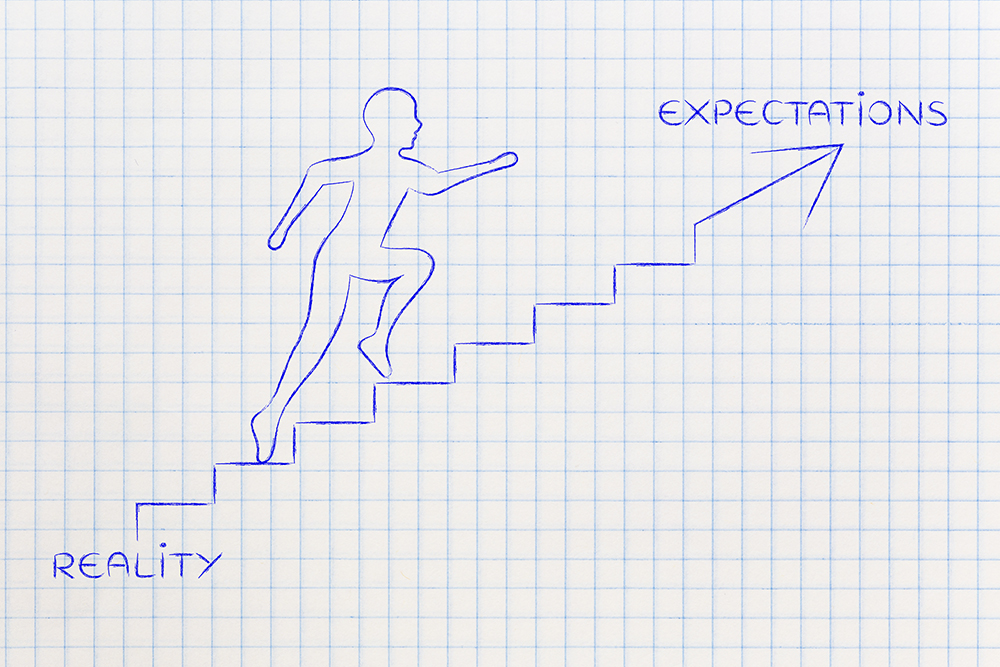Managing Expectations
Are you a design professional? Even if you’re not, you probably know a little bit about, or have had experience with, managing client expectations. Everyone manages expectations on a daily basis whether we realise it or not, and one of my favourite axioms is that a resentment is really nothing more than an unmet expectation. Wise, right?
I’ve had a few interesting conversations lately both with design professionals and potential clients. The chat with the pro (an interior designer) went something like this: “I want to be more clear about the design services I offer. Clients hire me and they think they’re going to get a whole house designed when the package I offer is really per room. Then they’re angry when I don’t deliver.” Unmet expectations! What is the solution to this? Communication is really the key, although I will be the absolutely first to tell you that people hear and see what they want to see. You could have a flashing neon sign that outlines exactly what a client will be getting, and they still have a vision in their head that they can’t let go.
“The greatest gift for a design professional is a reasonable, well-informed client who has done her research. A good client makes a good designer which makes a great end product!”
If you’re an interior designer, or really any type of designer, you most likely offer a contract or scope of work. This is important, because you always want something to refer back to when that unpleasant conversation comes up: “Well, I thought you were going to do this, this and that too.” So keep something written, or have clear, written terms on your site of what you will deliver. You can’t force people to comprehend this, but at least you have something solid to base that discussion on should it arise.
The other thing I’ve noticed about potential clients in all areas of design is they truly have no idea what something should cost. Like, none! And trust me, I’m the same. Like when it comes to cars. I know a Maserati is expensive, and I know it looks good, but under the hood I straight up could not tell the difference between a Maserati and a Ford. They function the same, they get you from place to place, but really, what is the difference? Apparently, I’m right, and it’s mostly under the hood, the unseen stuff. So a client sees a room by celeb interior designer Kelly Wearstler, and it looks amazing, but overall, it’s really just a room with some stuff in it right? So why can’t you (insert your name here, designers), deliver the same room? I’m sure most designers have been in this position no matter what your speciality.
I also recently had a great conversation with a potential client (I’m a graphic and web designer by trade). She had sent me a message with a list of her requests. She referenced some very high-end, expensive blogs and websites. She was super clear with exactly what she liked about those sites. Now, at first glance, a lot of websites look the same (like the new Fords look a lot like Jags at first glance). And trying to match a general look and feel is fine (eg. if a client says they like the chic boho feel of the Anthropologie website, it tells me what type of graphics to incorporate). Overall look and feel is important and totally attainable (eg. “I want a clean blog, splashes of pink, sans serif font”). But the extensive customization, not always visible at first glance, is not always within my scope of work. That’s where managing expectations comes in.
The really cool thing about this exchange was I gently pointed out to this client that with all of the features she was wanting, she was probably looking at about a $20k site (oh yeah, and that’s on the cheaper side). And you know what was amazing? She came back to me and said that she had been reaching out to other designers, and that was exactly in the neighbourhood of quotes she was getting. She was so nice and she completely understood. Instead of being horrified at the cost, she had done the research and realized that though sites may look really similar, when you start getting into a lot of customization, the price tag goes way up, way fast.
And that was fantastic. I gave her a few tips of things she could implement on her own, clearly she did not hire me because I explained I wouldn’t be able to provide what she wanted and I did not want her to be angry or disappointed with the end result, but it was an enlightening exchange. I just really appreciated her being so understanding and able to “see what she couldn’t see” if that makes any sense. By being open-minded and willing to do the research, she will make a good client for someone, just not my company.
I know if you’re any kind of creative design specialist you encounter the same issues, because sometimes the product you’re delivering is not necessarily cut and dried (like if you’re an office supply company, you’re delivering 100 printers, and that’s that). But design is subjective so it’s harder to create a scope of work. But if you’re a potential client for any type of design service, shop around. If you see a site you love, see if you can find out who designed it (most designers add a link in the site footer). Get a quote from them. If you go visit a friend and their house looks amazing, find out who did it, and call her. Then call celeb designer Kelly Wearstler!. The more research you do, the more understanding you will have of what something should cost. At my company, I keep our prices well within reason. I want to give clients a great-looking website at price they can afford if they’re just a part-time blogger or small business owner. But because of this, I want clients to understand that they won’t be getting a $10k or $20k website. The greatest gift for a design professional is a reasonable, well-informed client who has done her research. A good client makes a good designer which makes a great end product!
Working from Home: A Designer’s Guide
I just finished blow-drying my hair. Putting on makeup, and actually picking out an outfit. Including shoes! I might not leave my house today, but I’m ready for work.
Working from home can present any number of challenges. For most people who face a rushed morning followed by a slow and infuriating commute, working from home sounds like a dream. My friends get so jealous when they find out I work from home, and I know they have visions of me sitting around in pajamas all day, bingeing on Netflix and mowing through snacks. While this pretty much IS my evening routine, when it comes to 9 to 5 (or oftentimes more like 6 to 6), I’m all about business.
I’ve been working from home as a graphic and website designer for almost 8 years. I run a very busy and productive business so I’ve pretty much mastered the at home thing, and I’m really happy to share some of the tips I’ve learned along the way. Remote work is more and more common these days, but to be a successful remote or home worker, you have to have discipline.
For me, I have set work hours. While I don’t set an alarm, I automatically wake up around 6 a.m. Working from home (unless you are working remotely for a company with set hours) doesn’t necessarily mean you have to get up early. I’m a big believer in flex time, and I think that you should be able to work when you want and when you’re at your most productive. I know a lot of web designers who are most productive between the hours of midnight and 4 a.m., so if this is your jam, take advantage of it! For me, I happen to be at my best first thing in the morning (after coffee of course). But I get up every day like it’s a workday. I drink my coffee and check my email, and pretty much blow right into the day. I can get a lot done between 6 and 9 because I’m not interrupted by emails as much.
A really important thing I do is get dressed. I really feel strongly whether you’re a girl or a guy, that getting up, showering, shaving, and actually putting on clothes (real clothes, I don’t sit around in a suit all day, I just wear jeans (and yes I own like 20 pairs because that’s my wardrobe staple!)), but I actually do put on something that I would wear to a business casual office. I’m also a big believer in shoes. This may sound weird, but being showered and fully dressed with shoes on just makes me feel more productive. I already sometimes feel like I don’t have a “real job” even though I earn a solid income and have been in business for a number of years, and being fully dressed helps me feel more legit.
Opinions vary on this, but I actually do leave the tv on when I’m working, but only to news. Working from home can leave me feeling really disconnected and isolated, and having live news on (like CNN or BBC) lets me feel like I’m connected to the real world. I don’t find it distracting either, like I would if I were watching a show and I can’t mentally get past watching daytime television. Otherwise, I listen to music, or if I need to concentrate, silence (which you don’t get in an office).
“I’m a big believer in flex time, and I think that you should be able to work when you want and when you’re at your most productive.”
I’m also big on exercise. You don’t have to be an athlete, even just getting out for a brisk walk is important to clear your head. I usually wait till I get really mad at a client and then pound out a run (just kidding - sort of), but I do run every day, usually in the morning. This also helps with feeling less disconnected and it’s just good for you. Some people like to leave the house for lunch. I’m not a big daytime eater so this doesn’t interest me, but for some people, it works. In the past 6 months I’ve started playing tennis at lunchtime, but I’m not 100% on this. It’s good to break up the day, but on the other hand, when I’m in “the zone” leaving the house can be really distracting (and frankly, if you need to work a real 8 to 9 hour day, can eat up valuable time). But experts would probably agree that getting out of the house at some point during the workday is important. The other thing that I do is get out of the house at night. I have a pretty solid social life, so I try to do something in the evening - get a coffee, take a walk, hang out with friends, whatever. You don’t want to become a recluse. And speaking of friends, if you work from home it’s important to set boundaries with your friends. A lot of people think I can just pop out anytime in the middle of the day for coffee or whatever, and while technically this is true, it’s really not. My business is successful because I treat it like a real business. Whatever I wouldn’t do in an office I try not to do at home (okay this is a bit of an exaggeration, there are some major plusses to remote work) but like, I wouldn’t just dip out at 2:30 to go grab a latte if I worked in an office. A lot of times I don’t even tell people I work from home. I just let them think I work in an office because it cuts those sort of things off at the pass.
My final piece of advice on working from home is setting tech boundaries. I would work 15 hours a day if I could. So we already know all about how you’re supposed to turn off your phone before you go to sleep, etc. but if you work from home, tech boundaries are doubly important. Most people who work from home have a separate office, I actually prefer to work on my MacBook on the couch. It’s just more comfortable for me (though I might be paying for it later, ergonomically). So its even harder to create a boundary between work and home. The major thing I do is manage email. This requires some discipline, but I have my email open from when I get up to 5 p.m. At 5 p.m., email window goes off, not to be reopened till the morning. I also deactivated email alerts on my iPhone. The last thing I want to do is be out and about at night when I’m technically “off” and have someone dinging me. It can be dealt with in the morning. This is incredibly important. Some people go so far as to put their computer out of sight, shut the door to their office, etc., but you have to create a boundary between work time and home time. I also put any work-related paperwork, notes, etc. in a drawer, I don’t even want to see it when the day is done.
Working from home has its advantages, but you can’t put the cart before the horse. A lot of people start out with the goal of working from home. This doesn’t make sense to me, and it smacks of envelope-stuffing pyramid schemes. My company evolved organically, till it became prudent to “quit my day job” and begin working full-time for myself. I had no end goal of working from home, but it didn’t (and doesn’t) make sense financially to rent an office. I think if you do what you love and what you’re good at, you might be able to build it into a full-time business, but your end goal has to be doing what you love, not doing what you love so you can sit on the sofa!
I feel blessed to have such flexibility but there’s a lot of work behind it. I feel like I actually work more than my friends who have office jobs. It’s dedication and discipline (and lots of luck!) that have gotten my company to where it is today and I try to do everything I can to stay healthy and productive in my unconventional work environment.



